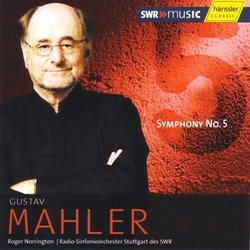Better than expected; a pleasant surprise
B. Guerrero | 01/09/2007
(4 out of 5 stars)
"Oh boy - oh boy; is it ever going to be fun to follow "professional" reviews of Roger Norrington's new Mahler 5. Is this is a case of Norrigton reinventing the wheel, or the emperor's new clothes? I'm leaning towards neither, and am judging it purely on its own musicality. In fact, other than the swifter tempi and vibrato-less strings in the famous Adagietto movement, there's little that's radically different. Perhaps more than anything else, what's truly different is just the way it sounds. First and second violins are divided across the stage (nothing new there); horns on the left; remaining brass on the right; double basses spread against the back wall. Recorded live, the perspective is from somewhere near the front. Yet, the brass don't blow you out of the room, except where they should (excellent brass chorale at the finale's big peroration). That said, the horns are rather prominent throughout. Woodwinds are quite far forward sounding, and the double basses have a happy home against the back - happy for us listeners; we can hear them! As with Norrington's Mahler first, the percussion are a bit inconsistent. However, the all important bass drum - greatly so in the third and fifth movements - is captured quite sufficiently (and not underplayed, either!). Hopefully, this gives you some idea of how it sounds. But what of Norrington's conducting?
Perhaps more than any other Mahler symphony, the fifth requires a tremendous number of subtle and not-so-subtle gear changes on the part of the conductor, especially in the second and third movements. I'm happy to report that Norrigton jumps through these hoops of fire rather brilliantly - far better than you might expect. In fact, the last six or seven minutes of the second movement - some of the most interesting and shifting music Mahler ever penned - are handled every bit as well as they were on the Sinopoli M5; the highlight of that release. The scherzo, to my mind, is right on the money as well. So far - so good, but I'm going save the Adagietto for last. The finale is worrying, as Norrington takes his time to smell the flowers along the way. Simply put, he's not in a hurry to get to the end of the symphony. But once we get there, Norrington really pours on the coals. Descending trombones scurry; horns whoop-up their fanfare figures, and Norrington drives hard with the brass at rehearsal figure 32 - this is truly exciting stuff! Then my next thought was, "is he going to hit the bass drum?". Then, "POW!" - there it is, right on target at rehearsal figure 33; which has the effect of propelling the chugging strings on to the reprise of the big brass chorale tune - the major theme of the entire symphony - which is located at the pesante marking six measures later. Success! But wait, what of the Adagietto?
The Adagietto will probably be the most talked about movement of all. Personally, I find it to be far more moving than Gilbert Kaplan's equally didactic correction that he recorded, as a single, with the somewhat dry sounding London Symphony strings (certainly as much a problem with acoustics, as with tone production). Vibrato or no vibrato, Norrington gets his Stuttgart strings to scoop and swoon; rush ahead, and slow down yet again. It ain't stiff! But just as important, the accompanying harps are quite far forward sounding, and Norrington gets plenty of amplitude and richness of tone at the movement's climax (great low strings!). If there's a shortcoming to this performance, I would say that it's with the first movement.
Norrigton sort of rushes the symphony's opening fanfare, and each subsequent fanfare variant. But on the other hand, that makes for an interesting shift in tempo each time we settle into the funeral cortege. Unfortunately, the soft percussion underneath the procession is underplayed, as is so often the case (why, oh why!?!). However, the fast breakout passage is really well executed, as is the tricky transition back into the slower tempo. All in all, as a prelude to the rest of the symphony, it's not bad. Everything else easily makes up for it, especially the ending."
Absolutely disgusting
Joseph Goodson | Ann Arbor, MI, USA | 11/24/2009
(1 out of 5 stars)
"Whatever interesting moment here or there Norrington might bring, I must say that this is absolutely disgusting, bloodless Mahler. The only proof you need is above: just listen to the small sample of the Adagietto -- with little to no rubato. You simply can't play Mahler this way and expect it to be Mahler. If you can stand listening to that after hearing the singing of the Adagietto in countless other places (Bernstein, Karajan, Haitink, just about anywhere else!) and still consider it the "same" piece of music, then, by all means, have at it."


 Track Listings (5) - Disc #1
Track Listings (5) - Disc #1